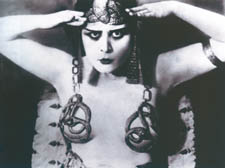|
|
 |
| |

Theda Bara became cinema’s first vamp as Cleopatra in 1917 with the help of Maynard Nottage |
History’s great publicists and lives of the kitsch and famous
After a madcap stunt at London Zoo, Mark Borkowski went on to become a top PR man. His new book examines the changing face of fame, writes Peter Gruner
The Fame Formula: Hollywood’s fixers, fakers and star makers
By Mark Borkowski, Sidgwick & Jackson £16.99
THE Urban Man suddenly appeared behind the bars of a cage at London Zoo and, for two weeks, became more famous than the animals.
He was an Italian performance artist who simply sat in his enclosure dressed in an evening suit, read a newspaper, tidied his cage, or scratched his head vigorously while gazing in boredom at the gawping crowds.
That was 25 years ago and, while everyone has long forgotten the him, the man who set up the publicity stunt on the actor’s behalf, Mark Borkowski, has become a legend in his own lunch-time. He is now the author of a fascinating new book, The Fame Formula.
Who would have guessed in those early, heady days at the zoo that the young, enthusiastic Borkowski, a one-man publicist in a natty bow tie with a tiny office in Camden Town, would one day help create a celebrity industry which, good or bad, would play a vital part in our national consciousness?
Today, with bigger offices in Farringdon, and a team of eager young wannabe PRs all trying to make a name for themselves in an overcrowded industry, he stands alongside Max Clifford and Matthew Freud among Britain’s great media manipulators. (Not, of course, that the media needs much manipulation these days).
His book is a history of the creators of the publicity industry, many of whom learned their showmanship craft from the circus and vaudeville. But it is also a tender tribute to the unsung heroes of showbusiness, the people whose perseverance made it all happen for the stars, but were then often discarded as no longer central to the cause of fame.
Those like early Hollywood publicist Maynard Nottage, who made celebrities out of stars of the silent screen. He created cinema’s first vamp, Theda Bara, in 1917, in her role as Cleopatra. He later hit the bottle and ended up forgotten, a bitter and twisted relic of a world that had moved on.
Nottage said: “There are supposed to be only seven or eight plots for a successful (PR) scam and each one has to work like a potter shapes clay at a wheel. The crucial element is in persuading an audience to love the potential star.”
But no matter how good a publicist is at his or her craft, if a star doesn’t shine on screen, then even with acting lessons they can soon fade away.
Gwili Andre, dubbed “America’s most beautiful model”, was a glamorous Danish artist’s model who came to Hollywood in 1932 and expected to become another Greta Garbo.
Borkowski writes: “She failed to blossom on celluloid, however. Her looks, according to the critics, did not translate from stills to the moving image as she apparently lacked animation on screen. Her contract was not renewed.”
The PR industry as we know it today really began with the great circus showman and self-publicist Phineas Taylor Barnum. He knew the importance of getting people talking about what he did. Borkowski writes: “One of the great untruths about Barnum is that he once said, ‘There is a sucker born every minute.’ He did, however, say, ‘Every crowd has a silver lining.’”
In the 1890s Barnum famously sought to buy Jumbo the elephant from London Zoo for what he described as the “Greatest Show on Earth.” There was a huge row in the press involving Queen Victoria about selling Britain’s favourite animal to an American circus entertainer. The dispute was deliberately stirred up by Barnum himself. But he managed to acquire Jumbo on the cheap by planting the suggestion that the elephant was a difficult and unmanageable beast.
Today Borkowski clients past and present include Eddie Izzard, Graham Norton, Van Morrison, Sir Cliff Richard, and the Bolshoi Ballet. He’s a big fan of the circus and a close friend of one of Britain’s great circus owners, Gerry Cottle.
But even Borkowski does not like some of the excesses of the fame industry, which on television has allowed people to become famous for being famous.
He suggests that the media is to blame just as much as the publicists.
“Journalists have become sucked into the fold,” he writes, “and consumed by the industry. They have become an extension of it rather than a necessary foil that will occasionally stand up and say ‘no’ to the worst excesses of a publicity hungry celebrity.”
Celebrity as we understand it now was invented the moment film-maker DW Griffths moved his camera to take a close-up of one of his stars in the early years of silent film, Borkowski says. “He transformed the base metal of the actor into the gold of celebrity. From then on, they were pursued and worshipped the world over.
“What the publicist has done is create a world that lives beyond the one enduring image, which encompasses fairytale and morality tale, fable and truth.”
|
 |
|
 |
 |
|
 |
|



